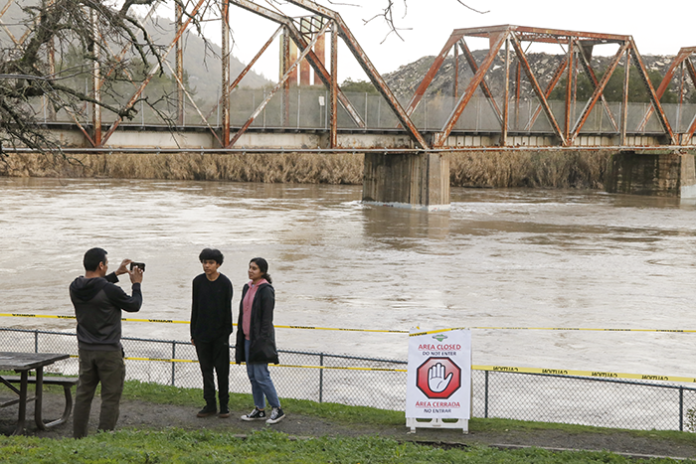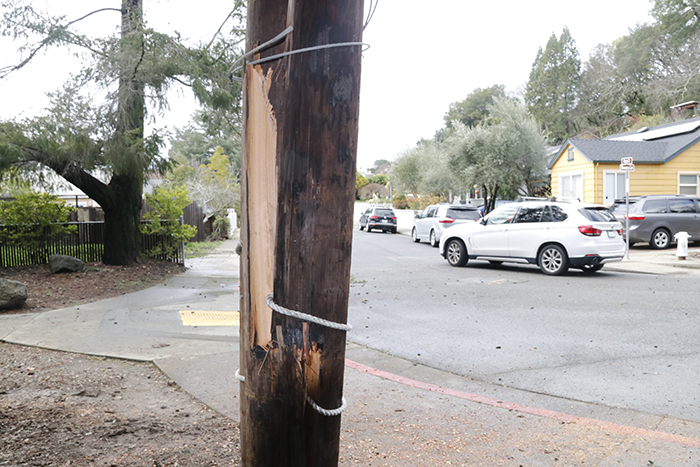
It has been called a lot of things: the Pineapple Express, Atmospheric Rivers, a Cyclone Bomb and the Open Storm Door. Whether or not Healdsburg residents need to come up with their own name for it, there’s every indication the January Storms of ’22 haven’t finished with them yet.
Wave upon wave of Pacific storms have rolled into California since before the New Year, and continue to do so. Rainfall is expected daily though the weekend, with more in the forecast for the next 10 days. Rivers are high, the ground is saturated, power is out in wide regions elsewhere in the state and, according to The New York Times, at least 17 have died.
The scale of the calamity came home to some Healdsburg residents on Saturday night.
As Healdsburg slumbered uneasily amid the howl of wind and roll of thunder, a tall conifer crashed to the ground near Giorgi Park at Reed and Bianca just after 11pm. The tree took down power lines and cables and split a wooden utility pole, cutting service to approximately 145 City of Healdsburg electric customers in the residential area.
For Steve Neilsen and family, at the house on the corner of that intersection, it was too close for comfort. “My daughter heard something and looked out the window to see it fall,” he said. A 40-foot cedar tree toppled to the ground, uprooting a cement walkway, destroying a hand built porch, pushing aside a metal storage house and crushing another on its way to demolishing part of the fence and taking down the power lines strung across the intersection.
“Good thing it didn’t fall the other way,” said Neilsen. He, his wife and three daughters moved into the residential neighborhood following the loss of their own home on Mill Creek to the fires of 2020. Compared to that disaster, this was an inconvenience.
City electric crews showed up in minutes and were able to reinforce the broken pole and, in a little over two hours, restore power. Roughly 132 customers were affected, though the city’s utilities manager, Terry Crowley, said “power to the remaining 13 customers was restored by 9:35am Sunday morning.”
Also down for the count were cable customers whose lines run in tandem with the city electric. “The City does lease pole space to both AT&T and Comcast, and both communication providers were affected by this tree,” said Crowley.

High Water Rising
The break in service was only one isolated incident in a wild weekend of wind, rain and floods, though many areas suffered even more than Healdsburg from falling trees, flooded roads and landslides. Still, the Russian River at the Camp Rose water gauge never came close to the 21-foot “monitor” level, as had been projected.
Monday night, a more robust lightning storm erupted over Healdsburg in the early evening hours, heralding the arrival of a new storm front. If meteorologists are correct, it won’t be the last: Rainfall is predicted for every day in the next week, until Thursday, Jan. 19, with another storm laying in wait after that.
“The endless stream of atmospheric river events will re-focus on Wednesday across northern California,” reported the National Weather Service, while warning that excessive rain on already saturated ground could produce more flooding. Heavy snow is in the forecast for parts of the Sierra and north, a hopeful sign for long term water management in 2023.
The series of storms has had an impact on water storage as well, and the reported water levels at both Lake Sonoma and Lake Mendocino are on the rise. “The series of recent storms has resulted in substantial increased pool elevations at Lakes Mendocino and Sonoma and unfortunately flooding on the Russian River,” Sonoma Water reported on Monday.
The two reservoirs comprise a substantial portion of water that Sonoma County residents use, as managed by the various water utilities coordinated by Sonoma Water. But as the agency pointed out, a significant part of their overall purpose is flood control—to hold back water in their storage reservoir in times of high rainfall, which can be released gradually as overall river levels fall. That’s how things are supposed to work, said Sonoma Water.
“The U.S. Army Corps of Engineers San Francisco District’s current plan is to continue to hold back water during the remaining series of storms this week,” their report continued. “The years-long drought has enhanced the ability of the lakes … to absorb all of the recent flows and recover after reaching historically low lake levels.”
One piece of good news comes with the latest rainfall readings, which show that for the first time in recent memory, the seasonal rainfall to date exceeds the historical average: From Oct. 1, 2022 to Jan. 8 of this year, 26.4 inches of rain fell in the local watershed area, compared to the 40-year mean of 19.79 inches. That’s 133% of average—not a bad omen for overcoming the drought.
Lake Sonoma was still below its average level for this time of year, with 72.6% of its 245,000 gallon capacity used. It’s another story at Lake Mendocino: the level there is almost 120% of average, well into the flood control pool level of the reservoir. Which means the Sonoma Water District “anticipates the likelihood for flood control release would occur at Lake Mendocino no earlier than Thursday January 12, 2023,” releases that could keep the Russian River high, even should the rains taper off.
Meanwhile, high wind advisories are being posted for the Bay Area, and the National Weather Service has advice that seems widely suitable: “Mariners should alter plans to avoid these hazardous conditions. Remain in port, seek safe harbor, alter course, and/or secure the vessel for severe conditions.”
For more information on flooding, visit healdsburg.gov/1046/Local-Hazards. To report flooding, downed trees that are not blocking a roadway or power outages, call the city’s 24/7/365 Emergency Utility Hotline at 707-431-7000 or toll free at 855-755-6586. For emergencies that pose a threat to life and/or property, such as a downed power line, or downed trees blocking a roadway, always dial 9-1-1.








